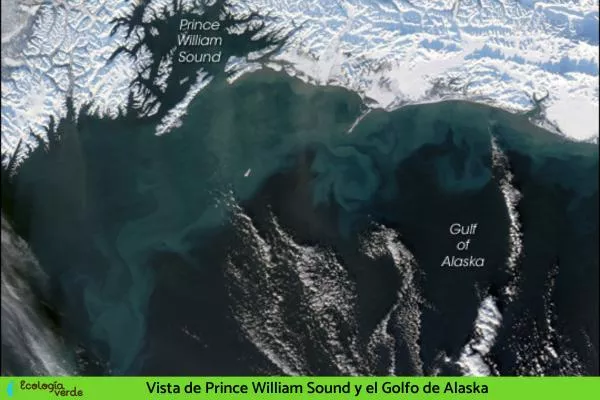
On planet Earth there are three great oceans: the Atlantic Ocean, the Indian Ocean and the Pacific Ocean. These three oceans, together with the seas, occupy approximately 71% of terrestrial territory. In this article we will focus on the Atlantic and Pacific oceans; both connected by the Strait of Magellan, the Drake Passage and another artificial passage with the Panama Canal. As we have mentioned, the two oceans are connected, but since a photo was circulating on the Internet for years where it seemed that their waters did not mix, the myth was created that the waters of both oceans did not mix.
Do not stop reading this article by Green Ecologist if you want to know why the waters of the Atlantic and Pacific oceans do not mix. Keep reading and we will explain it to you in detail.
Where the Atlantic and Pacific Oceans Don't Mix
The exact point where the Atlantic and Pacific oceans do not mix is at the gulf of alaska, where both oceans meet, but do not mix. In this place you can see color variations between the oceans, a spectacular visual effect that has a scientific explanation.
This scientific explanation is called eddiesIn other words, whirlpools of water 100 km in diameter that form ocean currents and convections and act as a natural engine. The eddies make possible the water and sediment distribution. They carry with them huge amounts of glacial sediment and clay that end up mixing only in one area of the sea. In this way, a natural and unique spectacle is created in which two waters of different color and density come together. This makes it appear that the waters are not mixed, but is it really true that the waters do not mix? We will explain it to you below.

Do the Atlantic and the Pacific really not mix?
The phrase that the waters of the Atlantic and the Pacific do not mix, it's just a myth. This myth was debunked by researcher Kenneth W. Bruland, who studied the whirlwinds of water that he later called eddies.
W. Bruland saw that the Copper River, a glacial river that flows east of Prince William Sound, was laden with heavy clay and iron-containing sediment. Once this glacier empties into a larger body of water, the sediments are collected by ocean currents moving from east to west. In this way, the iron found in the sediments from the glacial runoff and the clay end up reaching the ocean waters. You may be interested in knowing more details about The clay soil.
Therefore, the statement in the previous section in which it is said that in the Gulf of Alaska both oceans meet but do not mix, is not entirely true. It would be more correct to say that in the Gulf of Alaska, when the density of the waters is different, this natural phenomenon occurs in which It seems that the two oceans meet, but they do not mix.

Differences between the Atlantic and Pacific oceans
Once we have known why the two oceans do not mix, we are going to see what are the two main differences between the Atlantic and Pacific oceans.
Salinity
One of the most important differences between the Atlantic and Pacific oceans is salinity. The variation of this in both oceans is related to stations and latitude.
- The salinity of the Pacific Ocean is due to factors such as evaporation, precipitation and wind. The highest salinity values (approximately 3.5%) occur in the southwestern ocean, while the lowest values (less than 3.5%) occur in the extreme north. The fact that there is little salinity in this ocean is due, in large part, to the high rainfall: the higher the rainfall, the lower the salinity, and the higher the evaporation, the higher the concentration of loose salts in the sea.
- The Atlantic Ocean, on the other hand, is considered the saltiest ocean. The highest values of salinity are found in the north and south latitude and in tropical areas where rainfall is low and there is high evaporation. On the other hand, the lowest values occur north of the Equator. If you want to know more information about the Atlantic Ocean: characteristics, flora and fauna, do not hesitate to read this other article.
Temperature
The temperature of both oceans is another factor to take into account. Both the Atlantic and Pacific oceans look subject to variations in the layers of the water, in the seasons and the geographical latitude.
- In the Pacific Ocean the temperature it relates to the layers of water. For example, the deeper layers are colder than the upper layers and therefore the temperatures oscillate between -1.4 ºC and 30 ºC.
- In the Atlantic Ocean, however, the temperature depends depending on the seasons and latitude. The temperatures of this ocean oscillate in the -2 ºC, occurring to the north of the Ecuador the highest temperatures.
You may also be interested in the Green Ecologist article on the Distribution and dynamics of ocean waters, to finish training you on the subject.
If you want to read more articles similar to Why the Atlantic and Pacific Oceans Don't MixWe recommend that you enter our Nature Curiosities category.
Bibliography- Differences between the Pacific Ocean and the Atlantic Ocean. Oceanopacífico.org. Available at: https://oceanopacifico.org/diferencia-entre-el-oceano-pacifico-y-oceano-atlantico
- Endesa X. (2022). Gulf of Alaska: do two oceans collide ?. Endesa X. Available at: https://www.endesax.com/es/recursos/historias/golfo-alaska-choque-dos-oceanos


